State comptroller Tom DiNapoli just provided the strongest argument for a bold Open Culture program — jobs in the arts fell 61 percent last year during the pandemic (the Times and Gothamist covered DiNapoli's report).
The sector "is a cornerstone of the city’s ability to attract businesses, residents and visitors alike,” said DiNapoli's report [PDF]. “Yet the sector relies on audiences who gather to take part in shared experiences, and this way of life has been significantly disrupted by the pandemic.”
The report noted the existence of the city's Open Culture program (the Times story didn't), but it didn't explain how vitally important it is: right now, as Streetsblog has reported, the city has set aside 105 short segments of roadway (some of them along existing Open Streets) for qualified arts groups to hold performances. But almost no one seems to know about the program (at a forum about the future design of the 34th Avenue open street on Wednesday night, for example, the existence of the Open Culture program came as a shock to virtual all attendees. Other open streets activists have said they've heard similar reactions, or non-reactions, at other public space events).
"There is a huge communications gap between DOT, the Street Activity Permit Office, and artists/arts organizations," one arts insider told us.
It's time for this program — which starts in days! — to become better known and supported, just as the mayor's other car-free street programs (open streets and open restaurants) are supported.
Here's a link to the program's website (bring your lawyer). But let's get cracking, New York!
In other news from one of the slowest days of the last two months:
- Another New Yorker was killed in a hit and run, this time on notorious Hamilton Avenue in Brooklyn — and everyone covered it (Gothamist especially well, Brooklyn Paper). But would it kill the Daily News to include crash stats in its coverage of road violence so that readers knew not only that crash victims were great people, but also that any one of us could be similarly maimed and killed at any time? On Thursday, the paper wrote a touching story about victim Imorne Horton. But the paper didn't bother pointing out that the dark speedway under the Gowanus Expressway is a known danger zone. According to Crashmapper, there were 202 reported crashes, injuring four cyclists, three pedestrians and 44 motorists in 2019 alone — just on the three blocks of Hamilton between Smith and Henry streets. Those numbers are especially relevant given the Department of Transportation's testimony that it makes street design changes after about half of the fatal crashes every year. Keep us posted, DOT.
- Friend of Streetsblg (well, friend of everyone!) Jim Burke was on NY1 demanding that the Northern Boulevard protected bike lane get re-protected.
- In case you missed it, retired federal transit man Larry Penner has been on fire. He posted in Mass Transit about the flaw in Gov. Cuomo's plans for two major West Side transit centers, and he's even writing about buses in Buffalo in the Buffalo News.
- Stop the presses: U.S. Department of Transportation Secretary Pete Buttigieg was spotted on a bicycle yesterday in D.C. (Michael Stafford via Twitter)
- Having a dedicated, free parking space is a major influence on whether city-dwellers own cars, so less parking within developments results in fewer cars on the road, according to a new study. (Journalist’s Resource)
- And finally, don't forget to sign up for the Bike New York mayoral forum on Monday, March 1. It's not a debate — the candidates will take questions separately in this order: Kathryn Garcia at 6:30 p.m., Scott Stringer at 7 p.m., Eric Adams at 7:30 p.m., Shaun Donovan at 8 p.m., Andrew Yang at 8:30 p.m. and Ray McGuire (yes! Ray McGuire finally talking about bikes) at 9 p.m. Sign up to watch here.






